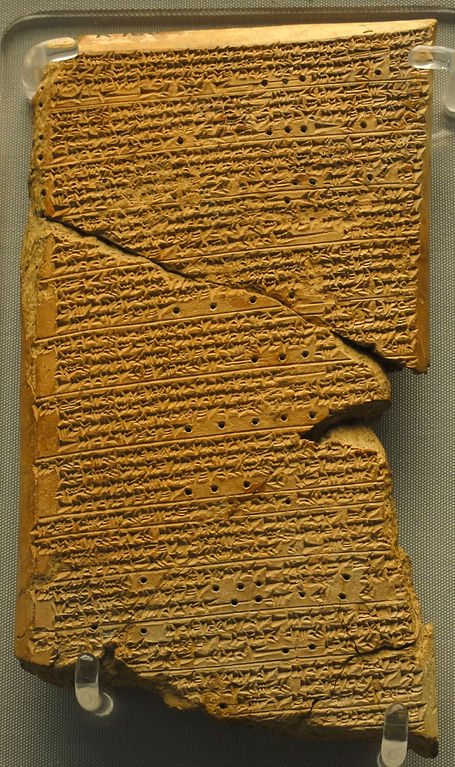
Caption: A copy of the Venus Tablet of Ammisaduqa which reports observations of Venus. The original (from which many copies were made) was compiled circa mid 17th century BCE (see Wikipedia: Venus tablet of Ammisaduqa). The copy is from the Neo-Assyrian period (934--609 BCE).
The Venus Tablet is a key document in the history of ancient Babylonian astronomy (c.1830--c.60 BCE).
Note Ammisaduqa (reigned c. 1646--1626 BCE, middle chronology) was a king of the dynasty of Hammurabi (reigned c. 1792--1750 BCE, middle chronology) (i.e., the dynasty of the First Babylonian Empire).
Features:
- We have many texts
from Ancient Mesopotamia
(or, loosely speaking, Ancient Babylonia)
since their inhabitants wrote on
clay tablets and
kiln-baked
clay tablets
buried in dry
earth (like that in
Tigris-Euphrates River area)
last for
thousands of years---millennia---a very
non-volatile memory
data storage medium:
- Many
clay tablets giving details of
Babylonian astronomy
have survived, and so we know a lot about
Babylonian astronomy.
This figure explicates an important
clay tablet
from Babylonian astronomy:
i.e.,
Venus Tablet of Ammisaduqa.
- The predictive
mathematical astronomy
of the
Babylonian astronomers
had simple beginnings in using cycles of repeated astronomical motions.
The Venus Tablet of Ammisaduqa is proof of this (from as aforesaid circa mid 17th century BCE) since it shows the Babylonian astronomers knew the Venus cycle as early as that (see No-290).
- What is the
Venus cycle?
Just the cyclic motions of Venus on the sky relative to the fixed stars, the Sun, and other astro-bodies. One could also say it is the cycle of planetary configurations (using the term broadly) of Venus.
The full time period of Venus cycle allows you to predict the location of Venus in the sky relative to the fixed stars and the Sun since almost exactly every 8 years, Venus returns to the same place relative to those astro-bodies.
To be more precise, the Venus cycle period = 2919.60 days = (8 Julian years (each 365.25 days) - 2.40 days) to 6 digit accuracy/precision.
- A further explication of the
Venus cycle
is given in
Babylon file:
venus_tablet_4.html
which may be just below if this is
Babylon file:
venus_tablet_4.html.
Credit/Permission: ©
User:Fae,
2010 /
Creative Commons
CC BY-SA 3.0.
Image link: Wikipedia:
File:Venus Tablet of Ammisaduqa.jpg.
Local file: local link: venus_tablet.html.
Extended file: Babylon file:
venus_tablet_4.html.
File: Babylon file:
venus_tablet.html.